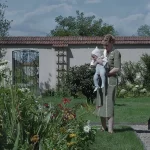More Is Less, by Aaron Pinkston
Out of nowhere, 2013 has been a great year for horror movies. I can’t remember the last year that had more than one really good horror flick, and we’ve already had Evil Dead, The Conjuring and You’re Next — three films that are nasty, scary, creepy and incredibly fun. I probably wouldn’t have been excited about the newest horror film to come in 2013, Insidious: Chapter 2, a sequel to a film I only mildly enjoyed, if it weren’t for one of those previously mentioned films. James Wan has been making mediocre horror films for the past ten years, but he really hit something with The Conjuring. That film wasn’t just a good creeper, but really showcased his ability and inventiveness as a filmmaker. Unfortunately, Insidious: Chapter 2 is more of a follow up to its franchise than his filmography.
I remember seeing Insidious on Blu-ray late one night in a dark room and with the sound turned way up. It was a perfect setup and I was appropriately unnerved. It hasn’t been a film that has held up in my mind since — all I can recall is the film’s great reliance on loud noises to induce startles and the rabbit hole of craziness (and not good craziness) of where it ends up. When Insidious was at its best it was an insular family drama with a paranormal spin. Insidious: Chapter 2 mostly gives us the inverse, opening up the world and getting further and further away from the little that made the first film shine. Producer Oren Peli’s Paranormal Activity series had a very similar problem as that franchise developed — heaping on a grander mythology on this world that doesn’t make the world more interesting, but much less so.
That being said, there is some inventive stuff going on in the main paranormal story. There is some spooky imagery and a unique twist to the film’s narrative that would work on its own. But I can’t help but have this sneaking feeling that much of the plot is put upon to cash this in as a franchise. Here comes some cynicism: because Insidious did so well at the box office, the producers and movie studio knew that they couldn’t just let it live as a singular story (which Insidious totally is). So, writer Leigh Whannell creates an unnecessary backstory for one of the characters that desperately wants to backtrack and make the original something that it wasn’t. If this plot existed in an original horror story it could have really breathed and lived on its own.
This is obviously Insidious: Chapter 2’s biggest problem, but it is buried by a strange tone and laughably bad dialogue. The movie is both ultra serious and completely ridiculous, leading to lines like (paraphrased, slightly): “I went into the spirit realm to save our son and something evil came out and killed Elise” delivered earnestly. Without any active knowing or actual reaction to the strange goings on, the results are very strange. Rose Byrne’s performance is the only one in the film that seems to come from some sort of real world place. When character’s don’t act appropriately to their experience it is difficult to come into the world with them. This is especially true of horror films, because the experiences are so very different than what we actually live. Patrick Wilson’s performance is the biggest offender of this — due to the narrative he is asked to play so seriously sinister, when no one around him reacts to him in a genuine way, it breaks the reality of the film.
There are moments in Insidious: Chapter 2 that really work — a few big ideas, a few small moments. As a whole, and especially as a sequel, though, there is more harm than good. If you were a big fan of Insidious, you’re probably all jazzed to see the sequel. Unfortunately, this is the kind of sequel that undermines what made you love it in the first place.



























